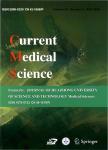Expression of Hypoxia-inducible Factor-1α in Liver Tumors after Transcatheter Arterial Embolization in an Animal Model
Expression of Hypoxia-inducible Factor-1α in Liver Tumors after Transcatheter Arterial Embolization in an Animal Model作者机构:Department of Radiology Union Hospital Tongji Medical College Huazhong University of Science and Technology Department of Radiology the Second Xiangya Hospital Xiangya School of Medicine Central South University
出 版 物:《Journal of Huazhong University of Science and Technology(Medical Sciences)》 (华中科技大学学报(医学英德文版))
年 卷 期:2009年第29卷第6期
页 面:776-781页
核心收录:
学科分类:1002[医学-临床医学] 100214[医学-肿瘤学] 10[医学]
基 金:supported by grants from National Natural Sciences Foundation of China (No 30970804) 863 Na-tional High Technology Research and Development Program of China (No 2006AA03Z332)
主 题:embolization hypoxia-inducible factor-1 liver neoplasms
摘 要:To examine the effect of transcatheter arterial embolization (TAE) of liver tumors on hypoxia-inducible factor-1α (HIF-1α) expression in the residual viable tumor, a total of 30 New Zealand White rabbits implanted with VX2 liver tumor were divided into 2 groups. TAE-treated group animals (n=15) were subjected to TAE with 150–250 μm polyvinyl alcohol particles. Control group animals (n=15) underwent sham embolization with distilled water. Six hours, 3 days or 7 days after TAE, the animals were sacrificed, and samples of tumor and adjacent normal liver tissue were harvested. Expression of HIF-1α protein was examined immunohistochemically. Real-time PCR was performed to examine the HIF-1α mRNA levels. Our results showed that HIF-1α protein was expressed in the VX2 tumors but not in the adjacent normal liver tissue. The HIF-1α-positive tumor cells were located predominantly at the periphery of necrotic tumor regions. The mean levels of HIF-1α protein were significantly higher in TAE-treated tumors than those in control tumors (P=0.002). Among the three sacrificing time points, the difference in increase in HIF-1α protein was significant between the two groups at the sacrificing time point of 6 h and 3 days after TAE (P=0.020, P=0.031, respectively), whereas no significant increase was noted 7 days after TAE (P=0.502). In contrast, although HIF-1α mRNA was expressed in TAE-treated and control VX2 tumors, there existed no significant difference in the HIF-1α mRNA level between the two groups (P=0.372). It is concluded that TAE of liver tumors increases the expression of HIF-1α at protein level in the residual viable tumor, which could be attributed to hypoxia generated by the procedure.



